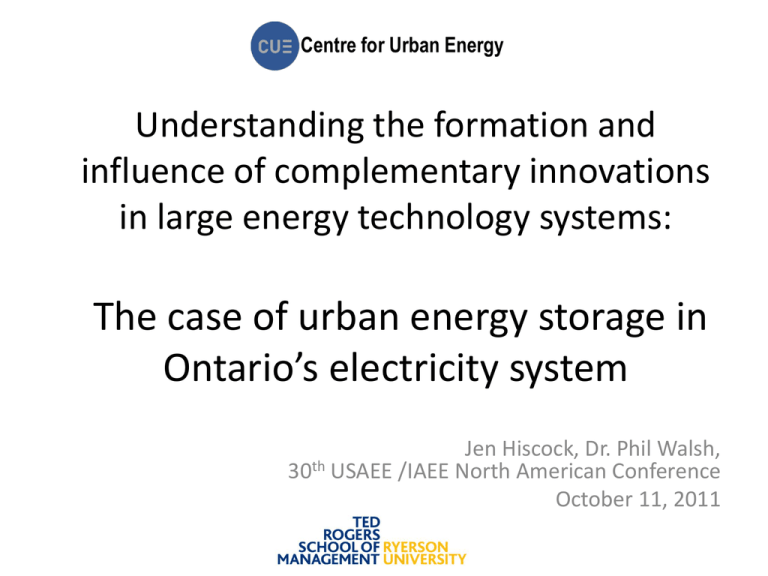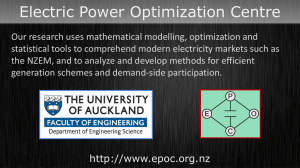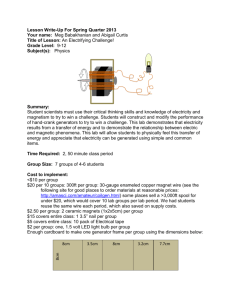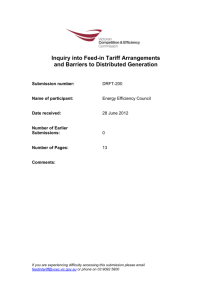Understanding the formation and influence of complementary
advertisement

Centre for Urban Energy Understanding the formation and influence of complementary innovations in large energy technology systems: The case of urban energy storage in Ontario’s electricity system Jen Hiscock, Dr. Phil Walsh, 30th USAEE /IAEE North American Conference October 11, 2011 Overview • • • • • • Ontario Context Research question & problem Institutional change theories Commercializing in an evolving industry Complementarity in institutional change Applying it to Ontario Change in Ontario’s Electricity Sector • Green Energy Act (2009) • Feed-In Tariff program (2010) – Focus on integrating renewable energy (wind, solar, biomass) into the grid • Designed with the intent to build a green economy in Ontario, meet environmental targets, and ensure reliable service • Change environment: resource pressures, politics, social pressures, technical requirements, economic capacity How do you integrate urban electricity storage? How do you commercialize urban electricity storage? Gans and Stern (2003) Commercialization Strategy Environments Walsh (2011) Environments for Commercializing Innovation Institutional theory and commercialization strategies • Adopt the perspective of the niche innovator Institutional Theory Rules, norms, routines, beliefs Emergence, conformity, conflict, change Organizational embeddedness Legitimacy Innovation Theory Lock-in, path dependence Price; cost-benefit Technology cycles, design competition Dominant design Business & Absorptive capacity, Diffusion; process technology push / pull innovation Resource-based views Core-competence Economic Theory Complementary assets Non-linearity Co-evolution of technology and society Sociology of technology Social order Actors, networks Actor-network and Evolutionary Theory Commercializing in an evolving market • Market dynamics amidst planned economy dynamics – Commercialization strategies integrated into broader institutional change processes • Institutional change models – Large infrastructure – Competition – Public sector intervention Integrated framework for TIS and MLP Landscape Patchwork of regimes Niches (novelty) mature phase Functional analysis of technology innovation systems (Bergek et al., 2008) formative phase Multiple levels as a nested hierarchy from the multi-level perspective of sectoral transition (Geels, 2002; 2010) Complementary Innovations Power quality, asset deferral, load management, ancillary services Reliability from intermittent renewables Decentralized electricity supply and storage The technology scope of the Smart Grid system. (Modified from: EPRI, n.d.) Integrated framework for TIS and MLP Landscape Patchwork of regimes mature phase Functional analysis of technology innovation systems (Bergek et al., 2008) Complementary innovations (Markard & Truffer, 2008a) Niches (novelty) formative phase Multiple levels as a nested hierarchy from the multi-level perspective of sectoral transition (Geels, 2002; 2010) Integrated framework in Ontario electricity Energy consumer networks, associations (commercial, industrial, residential) Price of inputs, Legislation, public pressure (OEB, IESO, Ministry) Local distribution companies (TH, HO, etc.) Electricity generators (OPG, Bruce Power) Li-ion batteries Smart grid tech. Wind / solar e- generators Electric vehicles Ontario Electricity Sector Stakeholder Map Landscape [OPA] [OEB] [IESO] Integrated Power System Plan Ministry Transitioning to a smart grid Directives (Hydro One, OPG) System Planner System Regulator System Operator Licensing Regulated Prices Generators Wholesale Market Distributed Market Electricity Prices 3rd Party Storage Service Complementary Provider Innovators Distributed Electricity Storage Generators Existing Regime Transmitters industry Feed-In Tariff Contract DES Distributors & generators Smart grid customers generators Hourly Market Price [~ ½ consumption] customers generators Regulated Price [~ ½ consumption] Distributed Electricity Storage Practical and Theoretical areas of insight • Practical – Commercialization strategies that leverage internal dynamics of institutional change – Understanding current system performance through functional analysis • Theoretical – Empirical evidence regarding the formation of and influence of complementary innovations • On decision making • On pathway development Thank you www.cue.ryerson.ca jhiscock@ryerson.ca prwalsh@ryerson.ca ? Key References Bergek, A., Jacobsson, S., Carlsson, B., Lindmark, S., & Rickne, A. (2005). Analyzing the dynamics and functionality of sectoral innovation systems–a manual. DRUID Tenth Anniversary Summer Conference, 2729. Bergek, A., Jacobsson, S., Carlsson, B., Lindmark, S., & Rickne, A. (2008). Analyzing the functional dynamics of technological innovation systems: A scheme of analysis. Research Policy, 37(3), 407-429. Boyer, R. (2005). Coherence, diversity, and the evolution of capitalisms—the institutional complementarity hypothesis. Evolutionary and Institutional Economics Review, 2(1), 43-80. Gans, J. S., & Stern, S. (2003). The product market and the market for“ideas”: Commercialization strategies for technology entrepreneurs. Research Policy, 32(2), 333-350. Geels, F. W. (2002). Technological transitions as evolutionary reconfiguration processes: A multi-level perspective and a case-study. Research Policy, 31(8-9), 1257-1274. Hekkert, M. P., & Negro, S. O. (2009). Functions of innovation systems as a framework to understand sustainable technological change: Empirical evidence for earlier claims. Technological Forecasting and Social Change, 76(4), 584-594. Markard, J., & Truffer, B. (2008a). Actor-oriented analysis of innovation systems: Exploring micro-meso level linkages in the case of stationary fuel cells. Technology Analysis and Strategic Management, 20(4), 443464. Markard, J., & Truffer, B. (2008b). Technological innovation systems and the multi-level perspective: Towards an integrated framework. Research Policy, 37(4), 596-615. Verbong, G. P. J., & Geels, F. W. (2010). Exploring sustainability transitions in the electricity sector with sociotechnical pathways. Technological Forecasting and Social Change, 77(8), 1214-1221. Walsh, P. R. (2011). Innovation nirvana or innovation wasteland? Identifying commercialization strategies for small and medium renewable energy enterprises. Technovation, doi:doi:10.1016/ j.technovation.2011.09.002










